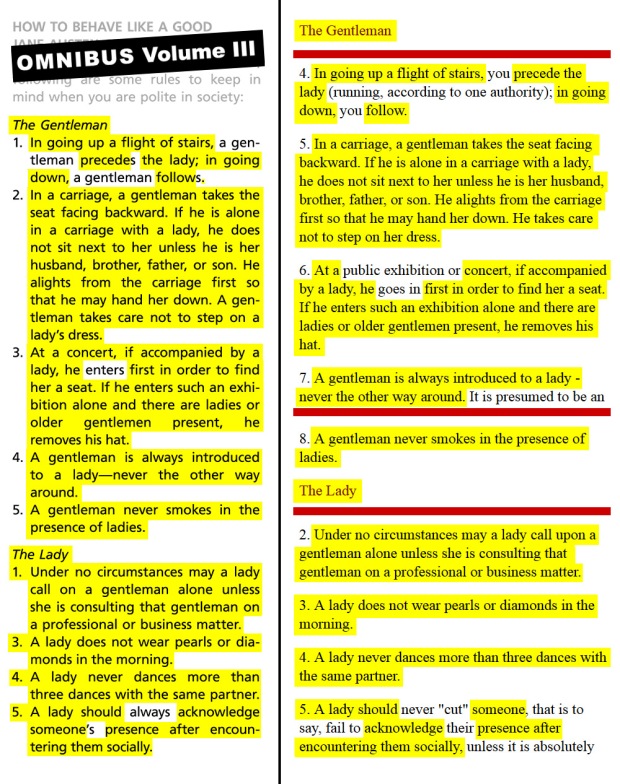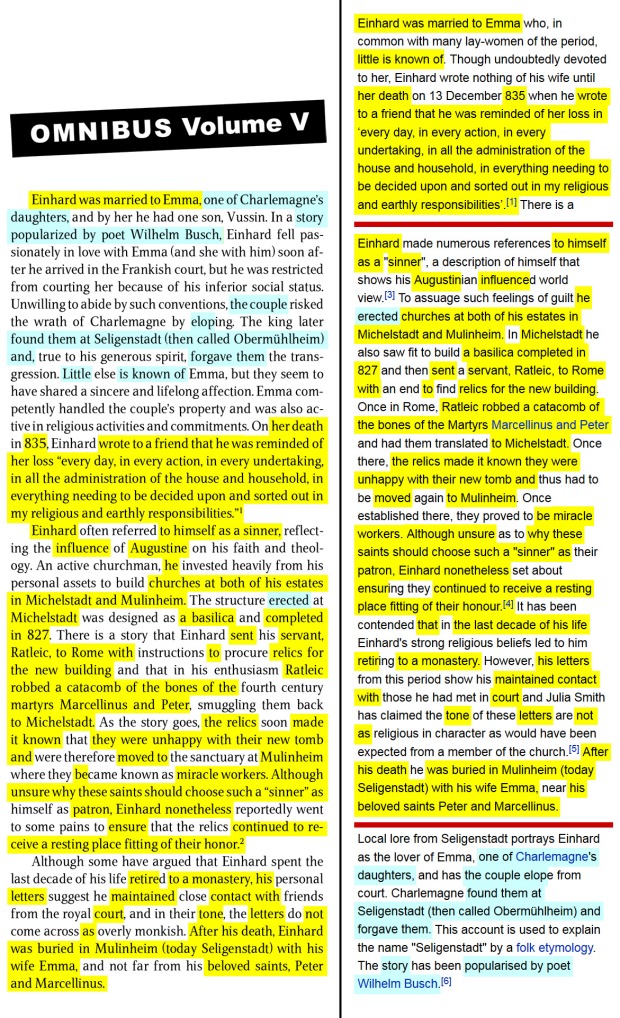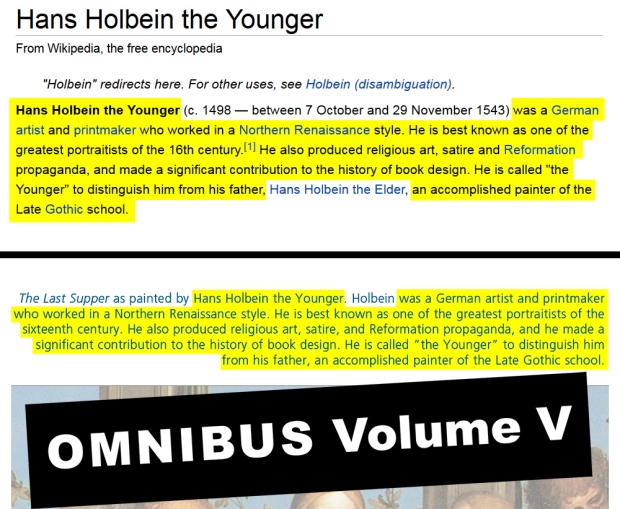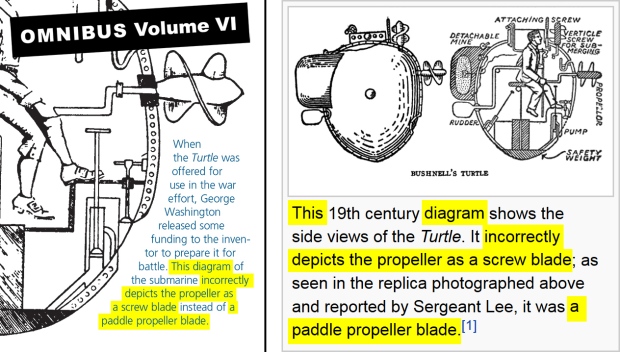As I noted in the last post, Doug Wilson’s views on theology, history, slavery, patriarchy, marriage, sex, etc. are present in materials that many CCE schools, programs, and homeschools use. In doing my research, I focused on the six-volume Omnibus produced by Veritas Press. Veritas Press is owned by Marlin and Laurie Detweiler who were members of Wilson’s CREC denomination.
The Omnibus Curriculum consists of six volumes covering the time periods from classical civilizations to the modern era. The material is intended for students in grades 7-12. Each volume consists of essays and “sessions” discussing the “Great Books.” The Omnibus volumes range between 500-800 pages in length and cost from $75-$100 each. The first three volumes were edited by Doug Wilson and G. Tyler Fischer. Volumes 4-6 were edited by Wilson, Fischer, and Gene Edward Veith. The first volume was published in 2005, and the last volume was published in 2011.
From the description on Christian Book Distributors website:
In Latin, Omnibus means “all encompassing.”
The Omnibus Curriculum from Veritas Press is designed to help enlighten, train, and develop young minds through the study of everything important, long-lasting, and true: the ideas, arguments and expression of the Western Canon as expressed in the Great Books. …
Each volume features lists of both Primary and Secondary books. Primary books are the traditional Great Books, while the Secondary books provide balance in the areas of Theology, History and Literature …
Each chapter covers a Great Book, examining the author, context, significance, main characters, summary and setting, worldview, and providing an in-depth essay analyzing and teaching the important points of the work. Chapters conclude with five sessions that provide questions to consider, optional activities, reading assignments, cultural analysis, biblical analysis, application, summa questions, recitation comprehension questions, lateral thinking, review questions, and evaluation questions. …
Covering literature, history, and theology from a solidly Reformed perspective, editors Douglas Wilson and G. Tyler Fischer weave their understanding of God’s providence and sovereignty throughout history.
In reading through various essays from the Omnibus Curriculum, I found examples of Doug Wilson’s influence throughout. I decided to organize the material here using the list of topics from my post, A Question for Wilson Fans. I’ve made some adjustments, but the basic format was useful in categorizing.
First is the issue of credentials. As Wilson’s own credentials are questionable, he has never been to seminary or been ordained, it seems that many of the Omnibus essay authors do not have the credentials one would expect from this type of curricula. There is no biographical information in the Omnibus for the authors of the essays and sessions. Some of the names were familiar to me as various CREC pastors or members of Wilson’s family. Other names I found through Google, some of them were teachers or administrators at CCE schools, others were former students from New Saint Andrews, Wilson’s college. A few names were of professors from Patrick Henry or other colleges.
The bulk of the essays and sessions were written by Wilson, his family members, and CREC pastors and elders. Wilson wrote over 30 of them himself. Many of his essays were on literature outside the areas of his educational background. His degrees are in philosophy and classical studies. In Texas, in order to certify to teach at the secondary level, a teacher has to have a certain number of college hours in a subject. To use myself as an example, I have the credit hours to certify in History, English, and Spanish.
While Wilson lamented in Recovering the Lost Tools of Learning that many teachers in today’s schools are not experts in their subject matter (RLTL, Kindle Locations 1587-1589), it doesn’t seem that the authors of the Omnibus essays and sessions fared much better, with a few notable exceptions. Gene Edward Veith and David Ayers, among other college faculty, are clearly qualified to write on the topics of their essays. Other authors may also be qualified, but without biographical information, it’s hard to know.
The author of one essay, Michael Metzler, wrote that he was asked to write his essay on Oresteia, a group of Greek tragedies, but he “had never even read a greek tragedy”:
A few years ago I agreed with Veritas Press to write for their first Omnibus text book. True, I was an old friend of Marlin Detweiler, and I even remember offering a little bit of volunteer help when the Detweilers were developing those world famous flashcards, but I don’t think this connection has much to do with my obtaining of the assignment. The assignment was an introduction to Aeschylus’ Oresteia … Although the marketing literature of Veritas Press spoke of the “experts” that were writing for this new release, I must confess that I had never even read a greek tragedy.
As I mentioned in yesterday’s post, Wilson’s views on slavery and history show up in the Omnibus curriculum. Those familiar with Wilson’s book Black and Tan should recognize the line of thought in these quotes. I should note that not all of the following quotes were written by Wilson. Many of the examples here and further down will be from other authors, but the point is that views that Wilson has made public through his own writing appear in these Omnibus essays and sessions.
In the essay and sessions on Uncle Tom’s Cabin, Toby Sumpter writes:
While Harriet Beecher Stowe’s work was by far the most popular, there were also popular novels of the period written from a Southern point of view, seeking to show that most slaves were treated fairly and compassionately. These stories show many slaves being given opportunities to learn, attend Christian worship services, and in many ways being treated as members of the family. These novels attempted to show how there were often “covenantal” ties that were thicker than blood existing between masters and servants, with mutual love and respect existing between them. (Omnibus III: Uncle Tom’s Cabin, pg. 177)
In the essay and sessions on Slave Narratives, the author (Wilson, Fischer, or Josh Stevenson) writes:
As you read through the Slave Narratives, exclude the abolitionist argument that the relation of master/slave is necessarily wicked. (Omnibus III: Slave Narratives, pg. 201)
And,
The problem the abolitionists had was … they wanted to maintain that the very relationship of slave and master was prima facia, or on its face, immoral. … The abolitionists rejected the authority of Scripture when it came to slavery, and many faithful Christians were right to resist them at this point. (Omnibus III: Slave Narratives, pg. 203)
Wilson’s book, Black and Tan, is listed at the end of this essay as additional recommended reading.
The following quote is from an essay by William Chad Newsom on Battle Cry of Freedom. It also demonstrates Wilson’s influence on the issue of slavery and the Civil War:
But while McPherson acknowledges the presence of complex factors and the reality of Southern ideals of constitutional liberty, and while he is usually careful to avoid coming across as biased, he nevertheless casts his lot with the North, the Union, Abraham Lincoln, and the radical abolitionism and egalitarianism that provoked the war. (Omnibus VI: Battle Cry of Freedom, pg 257)
Wilson’s views on revolution and American independence are also apparent in the Omnibus essays. In Wilson’s essay “American and French Revolutions Compared,” Wilson explains why he calls the Revolutionary War a War of Independence:
Nevertheless, clear-headed Americans knew that what they had fought for was of a completely different order than what the French Revolution was seeking to establish. To blur them together is to be guilty of an historical slander, and it is to throw away one of the great achievements of the American founding—a righteous heritage. So we have already noted that War of Independence is the better name for our founding war. But in conclusion, let’s use the word revolution in order to set the two side by side, that we may look at them directly. The American revolution was legal; the French revolution was illegal. The American revolution was constitutional; the French revolution was unconstitutional. The American revolution was defensive; the French revolution was offensive. The American revolution was conservative; the French revolution was radical. The American revolution fought to preserve the existing form of government; the French revolution fought to annihilate the existing form of government. The American revolution had a clear and definite object; the French revolution never had a clear and definite object. The American revolution was righteous; the French revolution was unrighteous. (Omnibus VI: American and French Revolutions Compared, pg. 137)
It is worth noting that other essay writers in the Omnibus curriculum acknowledge the fact that contemporary sources call it the American Revolutionary War:
Revolutionary War I realize this name is not the best description of this conflict, but it is how Irving himself refers to the war. (O. W. Leithart, Omnibus VI: The Legend of Sleepy Hollow, pg. 536 End Note 1)
Next up is the issue of Federal Vision and other questionable theology. Because most of the essays on the books of the Bible in the Omnibus Curriculum were written by CREC and Federal Visionary pastors, various aspects of Wilson’s theology show up in many essays. What follows is some of what I found.
The first two quotes demonstrate the influence of Federal Vision teaching on justification:
Abraham was declared righteous by God before he was circumcised, therefore his right standing before God was based on his faith, not any good deeds. (Etter, Omnibus 1: Romans, pg. 518)
And,
James is significant in that it shapes our thinking in several important areas. First, it provides the perfect balance to the writings of Paul concerning true, saving faith. (Etter, Omnibus 1: James, pg. 527)
This quote from an essay and session on Robin Hood says that Christians can use deceit:
Is it proper to deceive deceitful people? Can we trick the wicked? Although Christians must use it extremely wisely and carefully, deceit can be a legitimate weapon against the wicked. (N.D. Wilson, Josh Stevenson, Omnibus II: The Merry Adventures of Robin Hood 370 (teacher’s edition))
Steve Wilkins in his essay On Plymouth Plantation writes that the downfall of the U.S. is partly due to the Pilgrims’ rejection of the liturgical church calendar:
The Reformers … wanted to retain the more historic observance of the Christian calendar. The Puritans saw even this modified position as dangerous and decided it was safer simply to throw out the entire calendar. But this did not mean there would be no “man-made holy days;” it only meant that distinctively Christian celebrations were replaced with other celebrations. Man cannot live without commemorations and celebrations. … The Christian celebrations were replaced with days which celebrated the accomplishments of the state (e.g. Artillery Day, Election Day). The calendar no longer centered around the life of Christ and the church but around the accomplishments of the body politic. Men celebrate what is important to their gods. (Omnibus III: Of Plymouth Plantation pg. 48-49)
N.T. Wright and the New Perspective on Paul have clearly influenced a couple of essays:
Paul was preaching a new cosmos, a new order, in Christ. The resurrection of Christ had already happened, and this reality was going to permeate the old social order and, as a result was going to overthrow it. (Wilson, Etter, Omnibus III: Philemon, pg. 279)
And,
And the gospel is not just about getting people’s souls into heaven when they die. The gospel does promise that, but it also promises far more. That “more” includes the transformation of all the cultures of all men. (Wilson, Fischer, Steveson, Omnibus III: Slave Narratives, pg. 203)
Wright is quoted in a couple of other essays and his books are included in the books recommended for additional reading.
Another example of questionable theology comes from the essay and sessions on The Old Man and the Sea. This is not orthodox, Reformed teaching on Christ’s death:
Hemingway likens Santiago to Christ, who gave His life for the greater glory of mankind. (Newsom, Stevenson, Omnibus III: The Old Man and the Sea, pg. 530).
James Jordan’s teaching on Adam as needing to grow in maturity appears in a handful of essays:
When God created Adam, He put him in a garden, naked as a newborn. He told Adam to carry out the priestly task of “serving and guarding” the garden (Gen. 2:15). Adam was allowed to eat from the Tree of Life, but before he received the fruit of the Tree of Knowledge he had to grow up. Life is for babies; knowledge or wisdom is for adults, who have their senses trained to discern good and evil (Heb. 5:14). Eventually, Yahweh would have allowed Adam to eat the fruit of knowledge, and his eyes would have been opened to judge and rule (cf. Ps. 11:4; Heb. 4:13). Eventually, Adam would have grown up from priest to king. (Leithart, Omnibus IV: Proverbs, pg 13)
And,
“Be perfect, as your Father in heaven is perfect,” Jesus tells His disciples in Matthew 5:48. When we hear that, we usually cringe, thinking that Jesus is being totally unreasonable. How can we be perfect? Don’t we still sin? Jesus’ demands are too hard for us, and we might decide that Jesus doesn’t really mean what He says. Jesus does mean what He says, but we often misunderstand it. In the Bible, the word “perfect” doesn’t usually mean “without sin.” Instead, it means “mature.” Jacob was a “perfect” man (Gen. 27:25), and so was Job (Job 1:8). Neither one was sinless, but they were both “complete.” They were both “grown-ups.” That is what the Bible is all about—showing us how to be “perfect,” to be “grown-ups.” Adam was a baby in the Garden of Eden, as naked as a newborn. God planned for him to grow up and put on a crown and a royal robe of glory. But Adam acted just like a baby, grabbing the food he wasn’t supposed to have, and so God put him out of the Garden. When Jesus came, though, He came to bring us to maturity. Jesus came to make us “perfect”—all grown up. (Leithart, Omnibus IV: Phillipians and Colossians, 377)
At one point, the Omnibus session recommends that students debate the issue of paedocommunion. It’s interesting to note the reasoning behind the suggestion:
Paedocommunion In our discussions on the Lord’s Supper, we discussed the differences of opinion between the four groups regarding the presence of Christ. We did not touch upon another debated issue regarding Communion—that is, the question of who should participate in this sacrament. While most churches only allow adults and older children to participate in the Lord’s Supper, more churches are now practicing what is known as paedocommunion, or child communion. Today, we are going to debate the question of who should participate in the Lord’s Supper. (Wilson, Etter, Omnibus V: Institutes of the Christian Religion, pg 307, emphasis added)
Wilson’s patriarchal views are also frequently seen in the Omnibus curriculum.
Genesis 2 describes the origins of sexual difference. How does Genesis 2 define masculinity and femininity? Genesis 2 shows that Adam is created to “cultivate and keep” the garden (2:15) and that Eve is created to assist him in this task. Adam is the leader, initiator, beginner of things. And he is also the guardian who protects Eve from spiritual and physical assaults. He puts his strength to work in service and sacrifice. (Leithart, Omnibus II: Macbeth, pg 195-196)
And,
From a Christian perspective, feminism must be seen as a reaction to the sins and abdication of men. If men were genuinely devoted to Christ-like masculinity, if they truly gave themselves for their wives and daughters as Jesus did for His bride, if men honored women as their glory and crown, the feminist movement would have had very little impact. Feminism is a movement about women, but it is just as importantly a movement that poses questions to men. What does it mean to be a man? Christian men are not supposed to be brutal, but Christian men are not supposed to be stuffed teddy bears either. Where is the balance? (Leithart, Omnibus II: Macbeth, pg 1)
And,
Why is Deborah’s victory over Jabin and Sisera bittersweet for Israel? It was bittersweet because on one hand, it was a great victory for Israel, and Deborah was a godly, decisive, courageous judge and prophetess in Israel. On the other hand, when she implored Barak to lead Israel into battle, he would only comply if she went along. She warned him that a woman would receive credit. The bitterness lies in the cowardice and laziness of the men in Israel. In her wisdom (and subtlety) Deborah praises “the princes of Israel who willingly fought” (5:9). (Lusk, Becker, Omnibus IV: Joshua, Judges, Ruth, pg. 487)
And,
Egalitarianism can mean many different things. I am here using it to describe the philosophy that, while much more obviously present today, was very much a part of the modern outlook in the nineteenth century: the idea that there must be no (or few) boundaries or hierarchies in human relationships and that all people must be “equal” in every possible way. This goes well beyond equal treatment under the law to include equality of income and lifestyle, and the rejection of traditional, biblical roles that give different, complementary spheres to the work and life of men and women, ruler and subject, master and servant. (Newsom, Omnibus VI: Battle Cry of Freedom pg. 274 End note 5)
Wilson’s teachings on marriage also appear in the Omnibus essays and sessions:
Paul views men and women as equal in worth, but different in nature and function. Men and women are created equally in the image of God; indeed, they can only fully image God in community with one another. Further, men and women share equally in the Fall and participate equally in Christ’s redemptive work. But they are also profoundly different, and those differences are more than just a matter of biology. Men and women were designed to complement one another, with their strengths and weaknesses fitting one another like two pieces of a puzzle. Men were made for taking initiative and exercising responsible leadership in both church and home, which the Bible calls “headship.” Women were designed to be helpers and completers. The woman’s role is different, but no less valuable than the man’s. Further, these roles are not arbitrary; they fit with our God-given natures as men and women. We see these basic orientations laid out in Genesis 1–3, where the man’s primary focus is his work in the world (3:17–19), while the woman’s primary focus is the home (3:16); by fulfilling these roles, men and women together rule over God’s good creation (1:26–28) (Lusk, Omnibus VI: 1 and 2 Timothy, pg. 446)
And,
These complementary gender roles are most clearly seen in marriage (Eph. 5:21ff). The man is the head of his household, taking responsibility for the state of those under his care. He is the primary leader, protector, and provider. The woman is to be in submission to her husband, as his helper, not because she is inferior to him (after all, God is called “helper” more than anyone else in Scripture!), but because he needs her support and aid to fulfill his calling in the world. John Piper defines masculinity and femininity this way: At the heart of mature masculinity is a sense of benevolent responsibility to lead provide for, and protect women in ways appropriate to a man’s differing relationships. At the heart of mature femininity is a freeing disposition to affirm, receive, and nurture strength and leadership from worthy men in ways appropriate to a woman’s differing relationships.13 These are excellent Pauline definitions. There are biblical/theological models that help us understand how men and woman can be equal yet relate asymmetrically to one another. In the Trinity, the Father and Son share in the same “Godness.” They are equal in every way. But they are not interchangeable pieces because they have different roles to play. In the economy of creation and redemption, the Son submits Himself to the Father (1 Cor. 11:2ff). (Lusk, Omnibus VI: 1 and 2 Timothy, pg 449)
And,
Of course, not all Christian men and women are called to be married, and in those cases, there are opportunities for alternative forms of service outside of home life (cf. 1 Cor. 7). But, statistically speaking, it is obvious God calls most people to marry, and the woman’s role as helper to her husband and homemaker for her children should be honored. (Lusk, Omnibus VI: 1 and 2 Timothy, pg. 456 End Note 10)
The last section I want to cover is the significant amount of disturbing material (sex, nudity, violence) in the Omnibus volumes. Some of it is text that reflects Wilson’s teachings.
All of the Omnibus volumes open with prefaces and information for parents and teachers. One of the prefaces has an advisory that explains the editors’ approach to the subject of sex, nudity, and violence:
Advisory to Teachers and Parents
In the course of history there has been much fluctuation on what has been deemed age appropriate for young students. And for those of us alive today, there remains great variation as to what is considered age appropriate. The material we have created and the books we have assigned address numerous subjects and ideas that deal with topics (including sex, violence, religious persuasion and a whole host of other ideas) that have been the subject of much discussion of whether they are age appropriate. The judgment we applied in this text has been the same as we apply to our own children. In the creation of this program we have assumed that it will be used by students in seventh grade and above. Furthermore, we have assumed that there is no part of the Bible deemed inappropriate to discuss with a seventh grade student. Therefore, the material assumes that the student knows what sex is, that he understands the existence of violence, that he understands there are theological and doctrinal differences to be addressed and that he has the maturity to discern right and wrong. The worldview we hold and from which we write is distinctly protestant and best summarized in the Westminster Confession of Faith. The Bible is our only ultimate and infallible rule of faith and practice. We encourage you to become familiar with the material that your students will be covering in this program in order to avoid problems where you might differ with us on these matters. (Omnibus I: Advisory, Preface, xi)
Many of the essays recommend movie versions of the books being read. A couple of essays have warnings (like the one below) about the content of those movies:
View the 1964 movie production Becket and write a movie review, commenting on its faithfulness to the record in Lives. Warning: Within the first hour there is quite a bit of female flesh, near nudity, and immorality insinuated to depict Becket and Henry’s companionship in carousing and hunting during Becket’s days as chancellor. An adult should preview the movie and note the times of the offending portions and be ready with the fast-forward or instead find clips of the significant scenes online. The opening scenes are particularly good in showing the king’s penance and the church’s pressure and power in the aftermath of Thomas’s martyrdom. After viewing the film, discuss the following questions (Doud, Omnibus V: Lives of Thomas Becket, pg 226)
One of the books that 9th graders (generally ages 14-15) are expected to read is the play, Death of a Salesman. The play contains profanity, suicide, adultery, and call girls. The Omnibus essay has an end note warning teachers. Note that the warning only mentions the “vulgar and profane language”:
Teachers should be forewarned. This play contains vulgar and profane language. Common wisdom has been to avoid these realities. We think it is more righteous and wise to deal with such matters as God’s Word does: carefully, yet forthrightly and honestly. (Leithart, Omnibus III: Death of a Salesman, pg. 554 End Note 1)
What follows are examples that are representative of the many disturbing images used in the Omnibus curriculum. It is especially disturbing because of how many there are. As a student of Medieval and Renaissance history, I know that there are many paintings and stories that are troubling. The issue is that there are options when choosing what to use in curricula. That they chose so many creepy images to highlight is troubling. (Each image can be viewed in full size by clicking on the image.)

(Leithart, Omnibus I: First and Second Samuel, pg. 74) Michelangelo’s David. While there are many nudes in the various Omnibus volumes, this one is particularly noticeable for the angle of the image. For whatever reason, this image was chosen when other angles are more common.

(Dawson, Omnibus II: On the Incarnation, pg. 62) The Sacrifice by Edward Knippers. This image has the distinction of being disturbing, nude, and a violation of the second commandment. There was considerable controversy at Covenant College over an exhibition of Knippers work several years ago.

(Merkle, Omnibus II: Beowulf, pg. 123) Artwork by Matthew Clark. The monster’s detached arm is vivid and disturbing.

(Vest, Omnibus II: The Divine Comedy: Inferno, pg. 232-233) Arwork by Matthew Clark. The caption for this image reads:
Judas, Brutus and Cassius get their just desserts for being traitors to both Lord and empire. Judas is head first as the worst sinner, Cassius the Epicurean screams in his torments forever and Brutus the Stoic suffers but utters no sound. He has a stiff upper lip for all eternity.

(Leithart, Omnibus IV: Proverbs, pg 20) I do not know whose artwork this is. If you do know, please let me know and I’ll add that information. This image appears to be a depiction of the adulterous woman from Proverbs based on the surrounding text.

(Wilson, Gore, Omnibus IV: Apocrypha, pg 245) Susanna and the Elders by Anthony van Dyck. There are other representations of Susanna and the Elders that are not quite so disconcerting, although the theme of the story is disturbing in itself. This is one of several images that depict violence towards women.
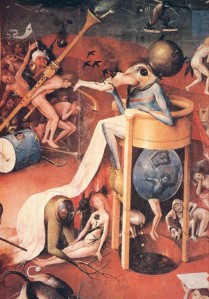
(Clark, Dennis, Omnibus V: Summa Theologica, pg. 112) The Garden of Earthly Delights by Hieronymus Bosch. From the description on Wikipedia:
Animals are shown punishing humans, subjecting them to nightmarish torments that may symbolise the seven deadly sins, matching the torment to the sin. Sitting on an object that may be a toilet or a throne, the panel’s centerpiece is a gigantic bird-headed monster feasting on human corpses, which he excretes through a cavity below him,[49] into the transparent chamber pot on which he sits.[53] The monster is sometimes referred to as the “Prince of Hell”, a name derived from the cauldron he wears on his head, perhaps representing a debased crown.[49] To his feet a female has her face reflected on the buttocks of a demon. Further to the left, next to a hare-headed demon, a group of naked persons around a toppled gambling table is being massacred with swords and knives. Other brutal violence is shown by a knight torn down and eaten up by a pack of wolves to the right of the tree-man.

(Tillman, Omnibus V: The Decameron, pg 515) The Banquet in the Pine Forest by Alessandro Botticelli. The caption reads:
The Banquet in the Pine Forest by Alessandro Botticelli (1445–1510) shows a portion of this story where, witnessing the horrible suffering of some ghosts, a young maiden realizes the cruelty with which she has treated a suitor and so consents to marry him.
Another source I read describes the image and the story behind it:
Directly after what we see in the second panel, the woman who has just been slaughtered rises up as if nothing has happened and Guido mounts his horse and begins to chase her all over again. It is explained that both Guido and the woman are dead. Guido killed himself over his unrequited love for the woman and he is doomed to hunt her for all eternity. The woman, due to her cold heart is doomed to flee from him. The scene Nastagio has witnessed will occur every Friday at the same time, without end.
Nastagio himself loves a woman who does not love him back. The third panel depicts the setup Nastagio has created to win over the woman he loves.
The dinner party depicted is “dedicated to frightening women into sexual submission” (Ricketts, 79) and we can see this through the way the women have all been seated together and have a front view of the gruesome scene.
It is also important to note that the women at the table have similar features to the nude woman Guido pursues and kills. Botticelli uses this resemblance to “imply that all the women were collectively affected…and that they were all potential victims.” (Ricketts, 85) Because of the possibility that they too could end up like this nude woman, the women’s response is exactly what Nastagio intended, which was “deferring to the men’s desires.”(85)

(Wilson, Hensley, Omnibus VI: American and French Revolutions Compared, pg. 137) The Able Dr. or America Swallows the Bitter Draught. Particularly disturbing is the lecherous guy looking up “America’s” skirts.

(Iverson, Etter, Omnibus VI: Huckleberry Finn, pg. 218) I’m not certain where this image originates. There wasn’t a name for artist or painting in the caption. But it is clearly meant to depict the torments of hell.

(Dawson, Omnibus VI: The Interpretation of Dreams, pg. 621) Oedipus and the Sphinx by Gustave Moreau. Again there are other images of Oedipus and the Sphinx that are less disturbing. This one is worse than most, even given the nature of the Oedipus story.
There are other images and more quotes that I could have used here. This is only a small sample. My purpose is to illustrate that the content of the Omnibus Curriculum has been influenced in many ways by Wilson and his heterodox views. I would strongly caution any family or school against purchasing and using this curriculum.


























































































